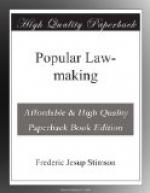words, “similar circumstances and conditions,”
in the Federal law may mean. There is no doubt
that actual differences in cost of service make dissimilar
conditions; but does geographical situation, such as
is recognized in the long-and-short-haul clause? or
still more, the amount of business offering, or the
amount of possible competition? Very early the
Interstate Commerce Commission and our legislation
got to the point of recognizing competition by water;
but the competition of other railroads was a thing
harder to recognize. Many people think they have
a right to a fairly equivalent service at a fairly
equivalent cost throughout the United States, and that
they have a right to all the advantages of their geographical
position. The farmers in Westchester County,
about New York, thought they had undoubted reason
to complain when the rates on milk were made the same
from their farms to the city as from farms in Ohio;
pointing out, indeed, that they had bought their farms
originally, and paid high prices for the land, for
the very reason of its geographical situation close
to a great market. Yet in our courts the economic
rule has usually prevailed; although no legislation,
so far as I have found, recognizes such differences,
except under some vague expression such as service
or discrimination “under like or similar conditions.”
Whether legislation will ever come to the point of
recognizing the railroad man’s shibboleth, “charge
what the traffic will bear,” is perhaps dubious.
And the new Taft Act, in its long-and-short-haul provision,
takes a long step in the direction of geographical
uniformity and rigidity of rates.
A few examples of modern rate regulation may be given.
In 1896 South Carolina fixed a flat passenger rate
of three and one-quarter cents per mile. Both
South Carolina and Virginia have empowered the railway
or public service commission to fix all rates, including
telephone and telegraph. Passenger rates are
now usually fixed at two cents per mile in the East,
or at two and one-half cents in the South or West.
In 1907 Kansas and Nebraska arbitrarily reduced all
freight rates fifteen per cent. on the price then
charged. In 1907 there was some evidence of reaction;
Alabama, in an extra session, repealed her law enacted
the same year prescribing maximum freight rates, substituting
more moderate rates in seven “groups”
(which, however, may be changed by the railway commission!),
and also enacted a statute directing the commission
and the attorney-general not to enforce the earlier
law; while the heavily penal Minnesota law was declared
unconstitutional by the United States Supreme Court.
In the British empire the power to fix rates is, of
course, unquestioned; and they are, as to railways
at least, generally regulated by law. Canada in
1903 established a railroad commission, and Nova Scotia
in 1908 imposed various restrictions as to tolls,
still the English word for rates. So in Ontario
and Quebec in 1906, and in Tasmania in 1901. In
many States, such as Victoria, the railways are owned
by the state, in which case, of course, no question
as to the right to fix rates can arise.




